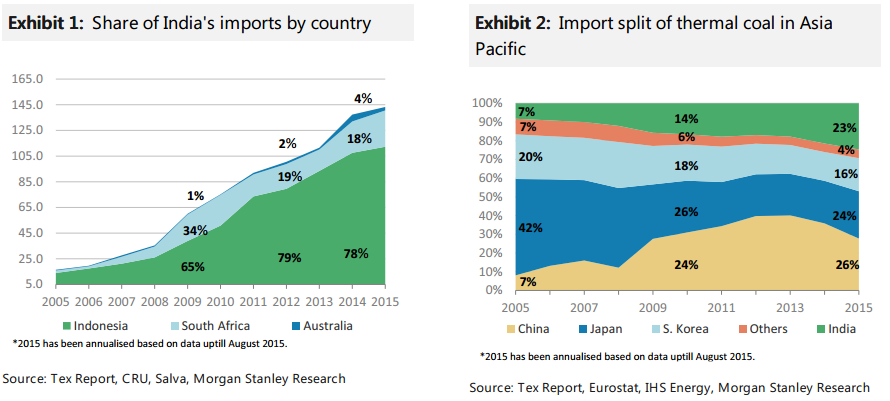From Bloomberg:
Coal consumption is poised for its biggest decline in history, driven by China’s battle against pollution, economic reforms and its efforts to promote renewable energy.
Global use of the most polluting fuel fell 2.3 percent to 4.6 percent in the first nine months of 2015 from the same period last year, according to a report released Monday by the environmental group Greenpeace. That’s a decline of as much as 180 million tons of standard coal, 40 million tons more than Japan used in the same period.
The report confirms that worldwide efforts to fight global warming are having a significant impact on the coal industry, the biggest source of carbon emissions. It comes a day before the International Energy Agency is scheduled to release its annual forecast detailing the ways the planet generates and uses electricity.
Poor old dirt. But it’s not all good news. India is free riding:
Slow ramp-up in domestic production has led to a rise in imports: India has the world’s fifth-largest reserves of coal (60.6Bt). However, the bulk of the resources are geographically separated from its principal areas of consumption, which, coupled with a lack of substantial infrastructure network, has led to delays in making production capacity available. In addition, the development of new projects has been stalled by difficulties in obtaining land and environmental approvals,causing domestic production to lag consumption requirements. Coal India Limited (CIL) supplies ~80% (494Mt in FY15) of India’s production and is targeting a doubling in production to 1Bt by 2020 in order to eliminate the country’s imports of thermal coal. However, achieving this target would require a production CAGR of ~15% to 2020, which looks optimistic when compared to an average growth rate of 4% per annum over the past three fiscal years.Indonesia has a 78% share of Indian imports, driven by cost and coal characteristics: India’s coal imports were 137Mt in CY14, growing ata CAGR of 23% over the past five years (Exhibit 2), with India expected to be the single largest importer in the seaborne market by CY16 (MSe: 150Mt) (Exhibit 3).The biggest winner from rising Indian imports over the past fiveyears has been Indonesia, with a market share of 78% in CY14, with South Africa second at 18% in CY14 (Exhibit 1). Indian coal, on average, has low energy content (typically 30-50% lower than internationally traded coals), high ash (30-50% ash) and low sulphur. This product is well suited to the country’s coal-fired plants, nearly all of which utilized subcritical technology until 2010. Indonesia has been the clear winner, for three key reasons: 1) its product is similar to the Indian domestic product, allowing it to bean easy feed source for plants, 2) proximity allows lower freight costs,and 3) Indonesian product is cheaper on a per tonne basis than other higher-calorific value coals traded in the international markets.
Australian coal will benefit if India continues to build super critical plants and it misses its own targets for domestic production. Both are likely but my view remains the uptake of Australian coal will remain marginal, sadly for the environment.


